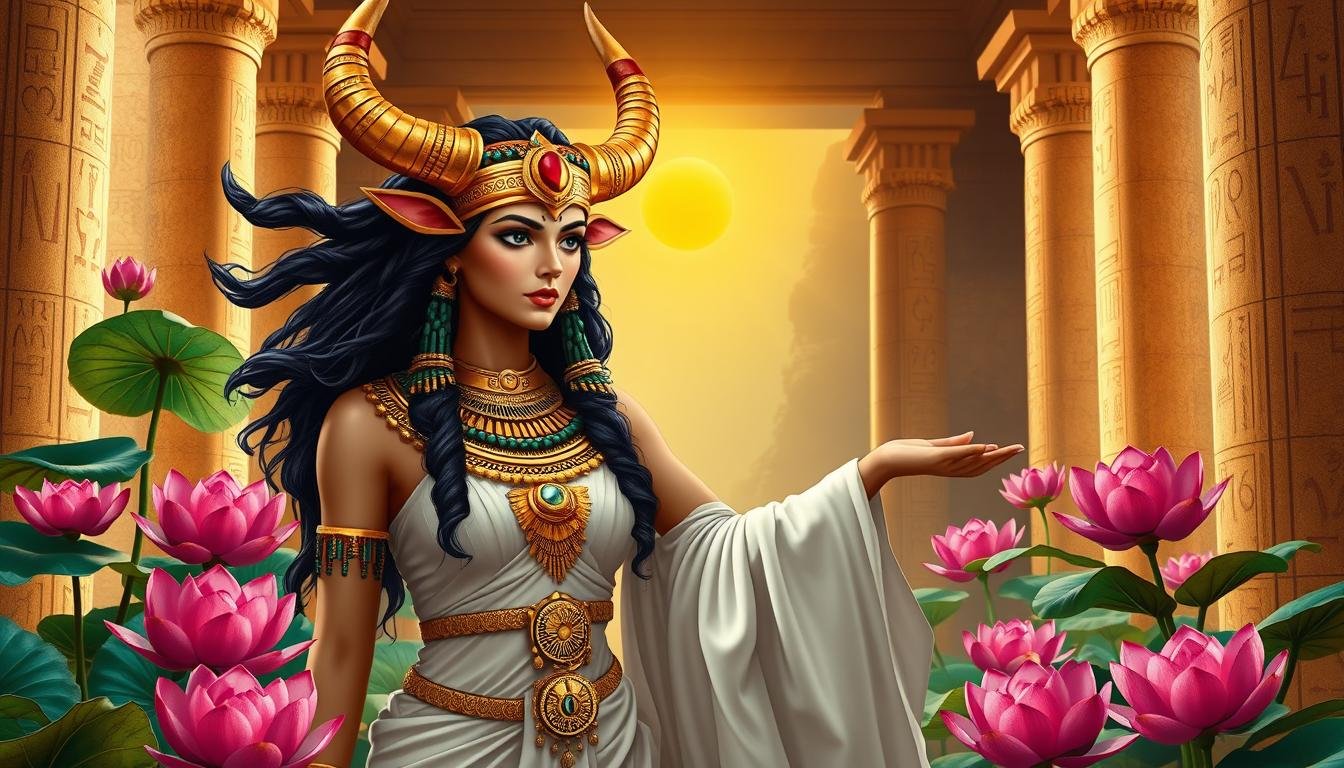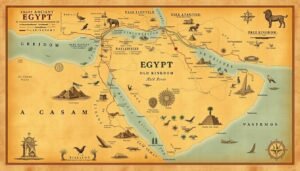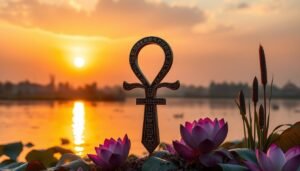In ancient Egypt, Hathor was a goddess of love, beauty, and joy. She was the daughter of Ra, the sun god1. People saw her as a protector of women and a symbol of femininity.
Hathor started as a cow-deity in the Predynastic Era2. Her fame grew, and her main temple was in Dendera3. People from all walks of life visited her temples for blessings3.
Install This 5000 Year Old ‘Egyptian Frequency’ In Your Brain To Manifest Money Effortlessly Like The Top 0.1% In 2024
Key Takeaways
- Hathor was the ancient Egyptian goddess of love, beauty, and joy.
- She was the daughter of the sun god Ra and was associated with femininity, motherhood, and fertility.
- Hathor’s primary temple was located in Dendera, which was the center of her worship.
- She was depicted in various forms, including as a cow or a woman with cow attributes.
- Hathor’s cult was extremely popular, with more festivals dedicated to her than any other Egyptian deity.
Hathor: The Alluring Goddess of Love and Beauty
Hathor was a beloved goddess in ancient Egypt4. She was seen as the “Eye of Ra,” a female counterpart to Ra4. Her name means “estate of Horus,” showing her bond with Horus and Ra5. As Ra’s daughter, she symbolized the sun’s daily journey4.
The Daughter of Ra and Embodiment of Femininity
Hathor was often shown as a cow or a woman with cow horns and a sun disk4. She was the goddess of music, dance, joy, love, and motherhood4. Her roles as mother, wife, and daughter of Ra mirrored the sun’s cycle4.
Her Worship and Festivals Celebrating Love and Fertility
Hathor was worshipped all over ancient Egypt, with more temples for her than any other goddess5. Her biggest temple was in Dendera, where she was called “The Golden One, Whose Rays Illuminate the Whole Earth.”5 Her festivals honored love, beauty, and fertility, showing her many sides5.
“Hathor was a major goddess in ancient Egyptian religion who played a wide variety of roles.”4
The Many Faces of Hathor: Goddess of Joy and Music
Hathor was a goddess in ancient Egypt known for joy, love, music, and dance6. She was worshipped for over 3,000 years. Her fame grew during the 4th Dynasty, lasting over 500 years6. This goddess, from the pre-Dynastic period over 5,000 years ago6, had many symbols and icons.
Her Animal Forms and Symbols of Motherhood
Hathor was often shown as a cow or a woman with cow horns7. These symbols meant fertility, nourishment, and care like a mother7. She was also linked to the constellation Mesketiu (now Ursa Major) because it looked like an ox’s hind leg6.
Her images included a celestial cow, a woman with cow features, or a goddess with a sun disk crown7. Hathor was also shown with a papyrus reed, snake, sistrum, and menat necklace7.
Hathor was a nurturing mother goddess in mythology and rituals7. She was seen as the Mother of the Pharaoh, giving her life-giving milk7. The Seven Hathors, under her, played a big role in the afterlife, deciding lifespan and death cause6.
Hathor’s animal forms and symbols showed her as a goddess of joy, love, and music7. Her connection to the sistrum instrument in rituals showed her as the goddess of pleasure and music6.
“Hathor was one of the oldest gods in the Egyptian pantheon, possibly originating over 5000 years ago in the pre-Dynastic period.”
Lady of Turquoise: Hathor’s Role as Protector of Foreign Lands
Hathor was a goddess in ancient Egypt. She was loved for her beauty and love. She was also the protector of foreign lands8.
She was known as the “Lady of Turquoise.” This was because of her link to the Sinai mines. These mines were rich in turquoise, a precious stone8.
Her worship went beyond Egypt. People saw her as a guardian of distant lands and their resources8.
Hathor’s tie to the Sinai mines made her very important in Egypt8. She was seen as a key figure in protecting these lands and their riches. This made her a beloved goddess in Egypt8.
Hathor was also connected to places like Nubia and Canaan. People gave her gifts like incense and stones9. This showed her role as a guardian of these lands and their treasures9.
Hathor’s role as the “Lady of Turquoise” was complex. She was a goddess beyond Egypt, loved by many. Her influence was vast, making her a standout in ancient Egyptian lore8.
Install This 5000 Year Old ‘Egyptian Frequency’ In Your Brain To Manifest Money Effortlessly Like The Top 0.1% In 2024
The ancient egyptian god of love: Nurturing Mother and Divine Consort
In ancient Egypt, Hathor was a special goddess. She was all about love, beauty, and caring for others10. People loved her so much that temples for her were built all over Egypt, like the famous Dendera10.
Her Union with Horus and Motherly Aspect to Pharaohs
Hathor was very close to Horus, the falcon-headed god. She was his wife and helped take care of the pharaohs as their mother11. She also helped guide souls to the afterlife, making sure the pharaohs were happy and safe.
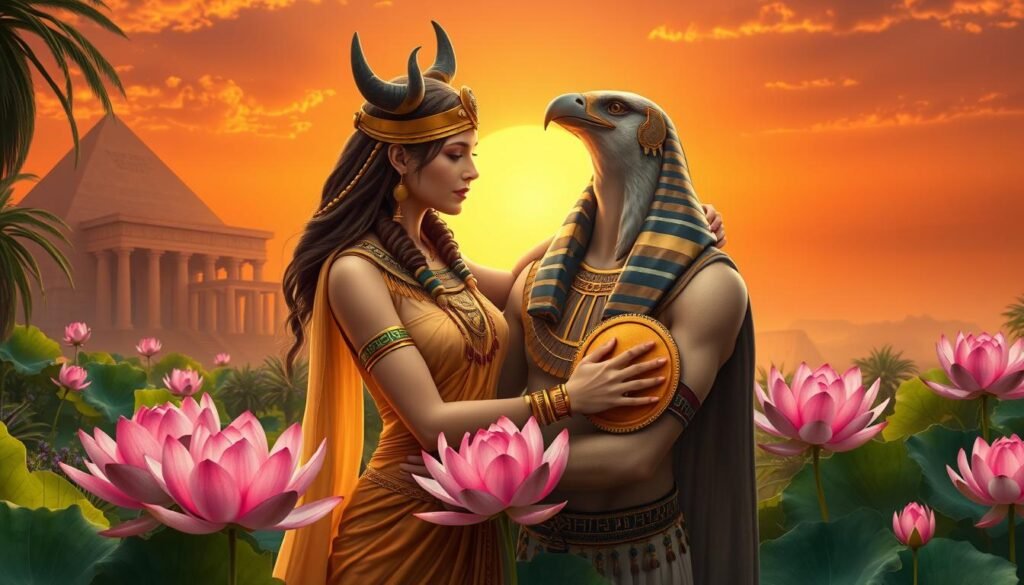
“Hathor was a goddess of many complex roles, from love and beauty to motherhood and the afterlife. Her close association with the pharaohs cemented her status as a revered and influential deity in ancient Egypt.”
| Hathor’s Roles | Significance |
|---|---|
| Goddess of Love and Beauty | Worshipped for her alluring qualities and ability to bring joy and happiness |
| Mother Goddess | Provided protection and care for women during childbirth, as well as for the pharaohs as a nurturing figure |
| Divine Consort of Horus | Linked to the mother of the pharaoh and the wife of the pharaoh through her relationship with Horus |
| Guide to the Afterlife | Welcomed departed souls and ensured the well-being of the pharaohs in the afterlife |
Hathor was very important in ancient Egypt11. She was loved for her roles as a loving mother and guide. Her bond with Horus made her a key figure in the lives of pharaohs and all Egyptians.
👉 How To Manifest Abundance Like The Elite
Hathor’s Cult Centers and the Festival of Reunion
Hathor was mainly worshipped in Dendera, but she was also honored in many other towns in ancient Egypt12. She became very important in the Fourth Dynasty, taking over from an early crocodile god at Dendera in Upper Egypt12. Every year, her statue was moved to Edfu for a big celebration called the “Festival of Reunion.”13 This event showed the special bond between Hathor and Horus, the son of Ra, in Egyptian myths12.
The Edfu temple, dedicated to Horus, is one of the best-kept ancient sites along the Nile, covering 6,430 m²13. Work on the temple started in August 237 BC and ended in September 142 BC, with King Ptolemy VIII there13. The temple’s building is detailed with exact dates, like the first stone laid on August 23, 237 BC, and finished on February 7, 70 BC13.
The Edfu temple was the site of many important celebrations, like the New Year and Horus’s victory over Seth13. Hathor was often shown as a cow with the sun disk between her horns, linking her to Ra12.
| Cult Center | Construction Period | Dedicating Deity |
|---|---|---|
| Dendera | 54 BC (Ptolemy Auletes) | Hathor |
| Edfu | 237 BC – 70 BC (Ptolemaic) | Horus |
| Kom Ombo | Ptolemaic and Roman | Horus and Sobek |
| Esna | Roman Period | Khnum |
The ancient Egyptians had over 1,500 gods, each with their own role14. Hathor was a key goddess, linked to love, beauty, music, and motherhood12. Her worship lasted until 30 BC, showing her lasting impact on Egypt’s culture121413.
The Veneration of Beauty: Cosmetics as Worship
In ancient Egypt, Hathor was a goddess of beauty and cosmetics15. She was one of the forty-two state gods and goddesses15. Her temple in Dendera was famous, showing her importance15.
Offerings of Mirrors and Palettes to the Goddess
People offered mirrors and cosmetic palettes to Hathor15. These items were sacred because of Hathor’s cult16. They were also buried with the dead, showing their spiritual value16.
Hathor’s journey to Edfu was a big event15. It celebrated her union with Horus. This showed how important she was in their religion15.
Hathor was also linked to Sekhmet and Aphrodite1517. This made her a complex goddess. She was about protection, beauty, love, and femininity1517.
The ancient Egyptians loved beauty and used cosmetics for worship1516. They gave mirrors and palettes to Hathor, seeing their spiritual value1516. Hathor’s story still fascinates us today, showing the power of ancient beauty and love.
Blending of Traditions: Hathor and the Greek Aphrodite
In ancient Egypt, the Greek Ptolemaic dynasty ruled from the 1st millennium BCE. During this time, Hathor, the Egyptian goddess of love, beauty, and fertility, connected with Aphrodite18. This showed how cultures could mix and exchange in the ancient world.
The Greeks saw Hathor as their own Aphrodite, goddess of love and beauty19. This mix was part of a bigger trend where Greek and Egyptian traditions merged. It led to new art and religious practices19. The sistrum, a sacred instrument, became a symbol of this mix, loved by both Greeks and Egyptians19.
In ancient Egypt, gods of love were fewer than in other cultures like Greece or Norse mythology18. But, their art and stories showed love’s big role in their lives18. Hathor and Aphrodite’s connection showed the power of love and beauty across cultures.
This mix of traditions wasn’t just in the Ptolemaic era. Throughout Egyptian history, love, joy, and fertility were key, with 25% of gods and goddesses linked to these18. Hathor’s cult and Egyptian mythology’s openness to new ideas show the ever-changing nature of ancient beliefs and the lasting charm of the goddess of love.
👉 What They Don’t Want You To Know About Manifesting Money
The Powerful Goddesses of Ancient Egypt
In ancient Egypt, there were many powerful goddesses. Isis, Sekhmet, and Ma’at were sisters in divinity20.
Isis was the goddess of love, fertility, and wisdom. She watched over the dead and gave fertility to people and animals20. Hathor was the goddess of joy, love, music, and dance. She helped with fertility for people and animals20.
Sekhmet was a lioness-headed goddess of healing and protection. She showed the sun’s power to heal and destroy20. Ma’at was the goddess of order, truth, and justice. She taught about honesty and fairness, which was important in Egyptian society20.
These goddesses were key to the beliefs and traditions of the Nile civilization21. They showed the power, wisdom, and authority of women22.
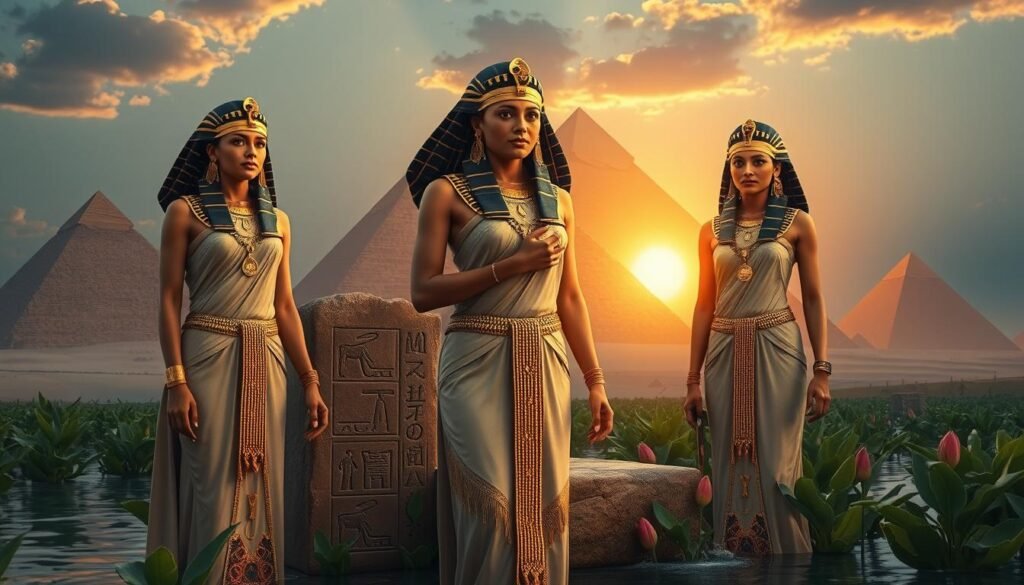
| Goddess | Attributes | Significance |
|---|---|---|
| Isis | Maternal love, fertility, wisdom | Watched over the deceased, blessed worshippers with abundance |
| Sekhmet | Healing, protection, strength | Depicted as a lioness, goddess of the sun’s destructive and restorative powers |
| Ma’at | Cosmic order, truth, justice | Emphasized honesty, integrity, and ethical behavior in Egyptian society |
“The ancient Egyptian goddesses embodied the fundamental elements of the natural and spiritual world, serving as archetypes of feminine power, wisdom, and divine authority.”
The Eternal Legacy of Hathor
Hathor, the ancient Egyptian goddess, still fascinates many today23. She was often seen as a cow-headed woman or a cow23. For about 3000 years, she was known as the goddess of the sky, love, and fertility23.
Hathor was loved and respected in many places24. She was seen as a symbol of love, joy, and beauty24. Her temples were filled with gold, showing her beauty and power24.
23 In a story, Hathor destroyed cities as Ra’s ‘Eye’23. But, she became kind again after drinking fake blood23.
24 Hathor’s marriage to Horus brought Egypt prosperity24. Her priests and priestesses taught love and joy through dance and songs24.
| Hathor’s Attributes | Significance |
|---|---|
| Goddess of Love, Beauty, and Fertility | Revered for her power to bring joy, harmony, and prosperity to ancient Egypt |
| Cow-like Features and Symbols | Represented her connection to the sky, motherhood, and the divine feminine |
| Transformation into Sekhmet | Showcased her dual nature as both a gentle deity and a fierce manifestation of wrath |
| Union with Horus | Symbolized unity, harmony, and prosperity for ancient Egypt |
Hathor’s legacy as the goddess of love, beauty, and fertility is still inspiring2324.
Conclusion: Unraveling the Mysteries of the Ancient Egyptian God of Love
Hathor, the ancient Egyptian goddess of love, beauty, and fertility, is fascinating. She shows us the rich world of ancient Egyptian gods25. Her story, from being Ra’s daughter to a nurturing mother, still captivates us today26.
Egyptian myths are still seen in movies, books, and games. This shows how much they still influence us25. Scholars and fans keep exploring these myths, showing their lasting appeal25.
Museums with statues and carvings teach us about these myths25. Themes like love and heroism in Egyptian myths are still loved today25. Learning about Hathor and other gods helps us appreciate ancient Egypt’s culture and legacy.
FAQ
Who was Hathor, the ancient Egyptian goddess of love?
Hathor was a very important goddess in ancient Egypt. She was the goddess of love, beauty, and music. She was also the daughter of the sun god Ra.
What were Hathor’s key attributes and symbols?
Hathor was often shown as a cow or a woman with cow horns. These symbols showed her connection to fertility and care. She was all about joy, love, and music.
Where was Hathor’s principal cult center and how was she worshipped?
Hathor’s main place of worship was Dendera. But she was also honored in many towns. Every year, her statue was taken to Edfu for a big festival.
How was Hathor associated with the pharaohs and the afterlife?
Hathor was the wife of Horus. She was seen as the mother of the pharaohs. She helped souls in the afterlife and protected the pharaohs.
What was the significance of cosmetics in Hathor’s cult?
Hathor loved beauty, and cosmetics were a way to worship her. People offered mirrors and cosmetic palettes to her. These were sacred symbols of beauty.
How did Hathor’s cult influence other ancient Egyptian goddesses?
Hathor was joined by Isis, Sekhmet, and Ma’at. Isis was about love and wisdom. Sekhmet was both fierce and healing. Ma’at was about order and justice.
How did Hathor’s cult spread beyond Egypt?
Hathor was loved in many places outside Egypt. She was known as the protector of foreign lands and their resources. She was called “Lady of Turquoise” in the Sinai mines.
How did Hathor’s legacy influence later Greek and Roman traditions?
In the Late Period, people wanted to be like Hathor in the afterlife. The Greeks saw her as their Aphrodite, the goddess of love. This shows how Egyptian and Greco-Roman traditions mixed.
Source Links
- Ancient Egyptian Gods and Goddesses – https://discoveringegypt.com/ancient-egyptian-gods-and-goddesses/
- Hathor – https://ancientegypt.fandom.com/wiki/Hathor
- The Cow Goddess of Love, Joy and Motherhood – https://ancient-egypt-online.com/hathor.html
- Hathor – https://en.wikipedia.org/wiki/Hathor
- Hathor: The Egyptian Goddess of Love and Beauty and the Fierce Protector of Ra – Mythology Gods – https://www.timelessmyths.com/gods/egyptian/hathor/
- Hathor – Mythopedia – https://mythopedia.com/topics/hathor
- Who is Hathor? by Gail – https://www.hathor.org.uk/about/goddess/
- Hathor: Ancient Egyptian Goddess of Many Names – https://historycooperative.org/hathor/
- Hathor, the Egyptian goddess – https://www.cleopatraegypttours.com/travel-guide/hathor-the-egyptian-goddess/
- Hathor – (Ancient Gender and Sexuality) – Vocab, Definition, Explanations | Fiveable – https://library.fiveable.me/key-terms/gender-sexuality-and-culture-in-the-ancient-world/hathor
- Egyptian Gods – The Complete List – https://www.worldhistory.org/article/885/egyptian-gods—the-complete-list/
- Hathor – Occult Encyclopedia – https://www.occult.live/index.php?title=Hathor&mobileaction=toggle_view_desktop
- Pharaonic temples in Upper Egypt from the Ptolemaic and Roman periods – https://whc.unesco.org/en/tentativelists/1824/
- Top 50 Ancient Egyptian Gods And Goddesses – https://www.egypttoursportal.com/en-us/the-most-famous-ancient-egyptian-mythology-gods-goddess/
- Hathor — The Paganista – https://www.thepaganista.com/blog/hathor
- Cleopatra’s Eye: The Significance of Kohl in Ancient Egypt – https://recipes.hypotheses.org/12837
- How to Connect to the Goddess Aphrodite – 6 Powerful Ways — A Simple Altar – https://www.asimplealtarblog.com/blog/6-simple-ways-to-connect-with-the-goddess-aphrodite
- The Goddesses And Gods Of Love (Ancient Egypt) – https://medium.com/@annalloydc/the-goddesses-and-gods-of-love-ancient-egypt-7fa505e40dda
- Depictions of traditional Greek deities and new cults | Greek Art and Architecture – 330 to 30 BC Class Notes | Fiveable – https://fiveable.me/art-of-ancient-greece-330-30-bc/unit-9/depictions-traditional-greek-deities-cults/study-guide/HyxGK7TTqVw2AXxq
- 4 Goddesses of Ancient Egyptian Mythology – https://acis.com/blog/4-goddesses-of-ancient-egyptian-mythology/
- Best time to travel to Egypt – Your guide for 2021 – https://egypttimetravel.com/ancient-egyptian-gods-and-goddesses/
- The Divine Women Ruling the Ancient Egyptian Pantheon: Meet the Goddesses of Ancient Egypt – https://www.wonderfulthingsart.com/post/six-goddesses-of-ancient-egypt
- Hathor: The Goddess to get a beer (or glass of milk) with – https://garstangmuseum.wordpress.com/2020/08/05/hathor-the-goddess-to-get-a-beer-or-glass-of-milk-with/
- The Story of Hathor, A Story Worth Reading on GatherTales – https://www.gathertales.com/story/the-story-of-hathor/sid-554
- Unraveling the Mysteries of Egyptian Mythology – https://medium.com/@wesfrank/unraveling-the-mysteries-of-egyptian-mythology-856e1b38ca53
- Ancient Egypt: Unraveling the Mysteries of Pharaohs and Pyramids – https://vocal.media/history/ancient-egypt-unraveling-the-mysteries-of-pharaohs-and-pyramids

